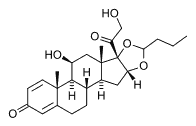Anaphylactic-like reaction associated with oral budesonide
Corticosteroids have antiallergic properties, which should reduce the likelihood of anaphylactic-like reactions. We describe a patient with an anaphylactic-like reaction associated with oral budesonide and apparent cross reactivity with mesalazine.
In 1995 a 29 year old woman with Crohn's disease started taking oral mesalazine (1 g three times dally) after ileocaecal resection. Within 48 hours her tongue and throat became swollen but returned to normal after the mesalazine was withdrawn. We evaluated her reaction to oral mesalazine (Pentasa, Yamanouchi Pharma; Asacol, Byk Nederland; and generic mesalazine prepared in the hospital's pharmacy) by giving her test doses (10 mg) in an outpatient setting. Within 30 minutes of exposure to each product, her tongue, buccal mucosa, and lips became swollen. Challenges with other drugs containing the same additives gave negative results. She had no history of asthma or nasal polyps.
In 1997 she started taking prednisone 20 mg daily and azathioprine 150 mg daily because of recurrent disease of the neoterminal ileum. In 1998 she started taking budesonide (Entocort, Astra Pharmaceutica) 9 mg daily because of weight increase. Dose tapering of the prednisone and azathioprine was planned after four weeks of budesonide treatment. Five minutes after she took the first capsule, her tongue and throat swelled, accompanied by transpiration, wheeziness, bowel complaints, and diarrhoea. She recovered within four days of treatment with clemastine. Intracutaneous tests with dilutions of budesonide suggested a non-IgE mediated reaction. Concentrations of urine methylhistamine outside the acute episode were normal, ruling out systemic mastocytosis. In 1999, after another ileocaecal resection, the patient's tongue and throat swelled after she received intravenous dexamethasone for prophylaxis against stress. She recovered after discontinuation of the drug and treatment with clemastine.
Published reports suggest that corticosteroid molecules are able to cause anaphylactic-like reactions.[1 2] Our report shows that anaphylactic-like reactions may also occur with oral budesonide and that cross reactivity may occur with mesalazine. Interestingly, sensitivity to aspirin, which is structurally related to mesalazine, has been postulated as a risk factor for anaphylaxis to steroids.[3]
The Dutch Medicines Evaluation Board and the manufacturer of budesonide, AstraZeneca, were informed. The manufacturer stated that allergic reactions to corticosteroids are more common than generally assumed and might be easily overlooked by clinicians.
Competing interests: None declared.
[1] Mendelson LM, Meltzer EO, Hamburger RN. Anaphylaxis-like reactions to corticosteroid therapy. J Allergy Clin Immunol 1974;54:125-31.
[2] Corominas N, Mane JM, Codina C, Paz MA, Ribas J. Hydrocortisone anaphylaxis: a new case report. Pharm Weekbl Sci 1992;14:93-4.
[3] Dajani BM, Sliman NA, Shubair KS, Hamzeh YS. Bronchospasm caused by intravenous hydrocortisone sodium succinate (Solu-Cortef) in aspirin-sensitive asthmatics. J Allergy Clin Immunol 1981;68:201-4.
M Heeringa, P Zweers, the Netherlands Pharmacovigilance Foundation Lareb,'s-Hertogenbosch, Netherlands, R A de Man, Department of Gastroenterology, H de Groot, Department of Allergology University Hospital Dijkzigt, Rotterdam, Netherlands
COPYRIGHT 2000 British Medical Association
COPYRIGHT 2000 Gale Group



